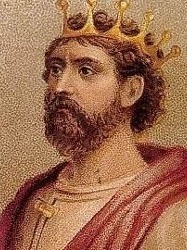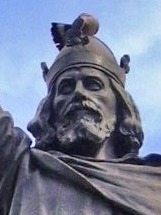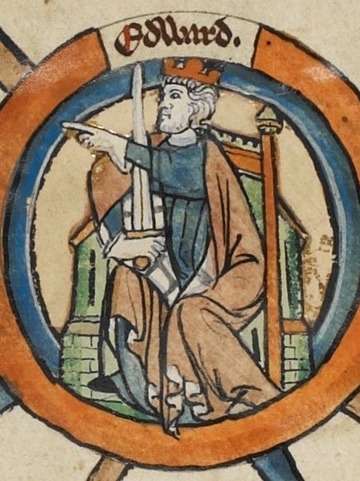Family Tree of Carlos Spartacus. » King Edmund I King of England (939-946),"the Deed-doer" the "Just" or "the Magnificent" (King Edmund I, King of England (939-946),"the Deed-doer", the "Just", or "the Magnificent") of England (± 921-946)
Personal data King Edmund I King of England (939-946),"the Deed-doer" the "Just" or "the Magnificent" (King Edmund I, King of England (939-946),"the Deed-doer", the "Just", or "the Magnificent") of England
Source 1- First name King Edmund I, King of England (939-946),"the Deed-doer", the "Just", or "the Magnificent".
- He was born about 921 in England.
- He died in the year 946. He was about 24-25 years old.
- A child of King Edward "The Elder",King of the Anglo-Saxons (899-924) King of the Anglo-Saxons and Eadgifu 3rd wife of King Edward the daughter of Sigehelm, Ealdorman of Kent.
Household of King Edmund I King of England (939-946),"the Deed-doer" the "Just" or "the Magnificent" (King Edmund I, King of England (939-946),"the Deed-doer", the "Just", or "the Magnificent") of England
He has/had a relationship with Queen Consort Aelfgifu of Shaftesbury of England.
Child(ren):
Notes about King Edmund I King of England (939-946),"the Deed-doer" the "Just" or "the Magnificent" (King Edmund I, King of England (939-946),"the Deed-doer", the "Just", or "the Magnificent") of England
dmund I (Old English: Ēadmund, pronounced [æːɑdmund]; 921 – 26 May 946), called the Elder, the Deed-doer, the Just, or the Magnificent, was King of the English from 939 until his death. He was a son of Edward the Elder and half-brother of Æthelstan. Æthelstan died on 27 October 939, and Edmund succeeded him as king.
Contents
[hide]
Early life and military threats[edit]
Edmund came to the throne as the son of Edward the Elder,[2] and therefore the grandson of Alfred the Great, great-grandson of Æthelwulf of Wessex and great-great grandson of Egbert of Wessex, who was the first of the house of Wessex to start dominating the Anglo Saxon realms. However, being born when his father was already a middle aged man, Edward lost his father when he was a toddler, in 924, which saw his 30 year old half brother Athelstan come to the throne. Edmund would grow up in the reign of Athelstan, even participating in the Battle of Brunanburgh in his adolescence in 937
Athelstan died in the year 939, which saw young Edmund come to the throne. Shortly after his proclamation as king, he had to face several military threats. King Olaf III Guthfrithson conquered Northumbria and invaded the Midlands; when Olaf died in 942, Edmund reconquered the Midlands.[2] In 943, Edmund became the god-father of King Olaf of York. In 944, Edmund was successful in reconquering Northumbria.[3] In the same year, his ally Olaf of York lost his throne and left for Dublin in Ireland. Olaf became the king of Dublin as Amlaíb Cuarán and continued to be allied to his god-father. In 945, Edmund conquered Strathclyde but ceded the territory to King Malcolm I of Scotland in exchange for a treaty of mutual military support.[3] Edmund thus established a policy of safe borders and peaceful relationships with Scotland. During his reign, the revival of monasteries in England began.
Louis IV of France[edit]
One of Edmund's last political movements of which there is some knowledge is his role in the restoration of Louis IV of France to the throne. Louis, son of Charles the Simple and Edmund's half-sister Eadgifu, had resided at the West-Saxon court for some time until 936, when he returned to be crowned King of France. In the summer of 945, he was captured by the Norsemen of Rouen and subsequently released to Duke Hugh the Great, who held him in custody. The chronicler Richerus claims that Eadgifu wrote letters both to Edmund and to Otto I, Holy Roman Emperor in which she requested support for her son. Edmund responded to her plea by sending angry threats to Hugh.[4] Flodoard's Annales, one of Richerus' sources, report:
Edmund, king of the English, sent messengers to Duke Hugh about the restoration of King Louis, and the duke accordingly made a public agreement with his nephews and other leading men of his kingdom. [...] Hugh, duke of the Franks, allying himself with Hugh the Black, son of Richard, and the other leading men of the kingdom, restored to the kingdom King Louis.[5][6]
Death and succession[edit]
On 26 May 946, Edmund was murdered by Leofa, an exiled thief, while attending St Augustine's Day mass in Pucklechurch (South Gloucestershire).[7] John of Worcester and William of Malmesbury add some lively detail by suggesting that Edmund had been feasting with his nobles, when he spotted Leofa in the crowd. He attacked the intruder in person, but in the event, Leofa killed him. Leofa was killed on the spot by those present.[8] A recent article re-examines Edmund's death and dismisses the later chronicle accounts as fiction. It suggests the king was the victim of a political assassination.[9]
Edmund's sister Eadgyth, the wife of Otto I, Holy Roman Emperor, died earlier the same year, as Flodoard's Annales for 946 report.[10]
Edmund was succeeded as king by his brother Eadred, king from 946 until 955. Edmund's sons later ruled England as:
- Eadwig, King of England from 955 until 957, king of only Wessex and Kent from 957 until his death on 1 October 959.
- Edgar the Peaceful, king of Mercia and Northumbria from 957 until his brother's death in 959, then king of England from 959 until 975.
Timeline King Edmund I King of England (939-946),"the Deed-doer" the "Just" or "the Magnificent" (King Edmund I, King of England (939-946),"the Deed-doer", the "Just", or "the Magnificent") of England
 grandparents
grandparents
 parents
parents
 brothers/sisters
brothers/sisters
 children
children
Ancestors (and descendant) of King Edmund I King of England (939-946),"the Deed-doer" the "Just" or "the Magnificent" of England
King Edmund I King of England (939-946),"the Deed-doer" the "Just" or "the Magnificent" of England  | ||||||||||||||||||||||||||||||||||
Relationship King Edmund I King of England (939-946),"the Deed-doer" the "Just" or "the Magnificent" (King Edmund I, King of England (939-946),"the Deed-doer", the "Just", or "the Magnificent") of England
- King Edmund I King of England (939-946),"the Deed-doer" the "Just" or "the Magnificent" of England is the 8th great grandson of King Ceolwald King of Wessex of Wessex:King Ceolwald King of Wessex of WessexCoenred of Wessex (Wessex)Ingild of Wessex (Wessex)Eoppa King of Wessex of WessexEafa King of Wessex of WessexKing EALHMUND King of Wessex of Kent (Wessex)Egbert King of Wessex (802-839) ( Ecgberht / Ecgbert / Ecgbriht ) of WessexAethelwulf King of Wessex (839-858) King of WessexAlfred The Great King of Wessex (871-899) of WessexKing Edward "The Elder",King of the Anglo-Saxons (899-924) King of the Anglo-SaxonsKing Edmund I King of England (939-946),"the Deed-doer" the "Just" or "the Magnificent" of England
Sources
- FamilySearch Family Tree, via https://www.myheritage.com.br/research/c...
Edmund I King of EnglandGênero: MasculinoNascimento: Entre 6 de Jan de 922 e 5 de Jan de 923 - EnglandMãe: Edgiva Kent
The FamilySearch Family Tree is published by MyHeritage under license from FamilySearch International, the largest genealogy organization in the world. FamilySearch is a nonprofit organization sponsored by The Church of Jesus Christ of Latter-day Saints (Mormon Church).
About the surname Of England
- View the information that Genealogie Online has about the surname Of England.
- Check the information Open Archives has about Of England.
- Check the Wie (onder)zoekt wie? register to see who is (re)searching Of England.
Carlos Fernando de Souza Silva Brogni, "Family Tree of Carlos Spartacus.", database, Genealogy Online (https://www.genealogieonline.nl/family-tree-of-carlos-fernando-de-souza-silva/I502028.php : accessed May 24, 2024), "King Edmund I King of England (939-946),"the Deed-doer" the "Just" or "the Magnificent" (King Edmund I, King of England (939-946),"the Deed-doer", the "Just", or "the Magnificent") of England (± 921-946)".



